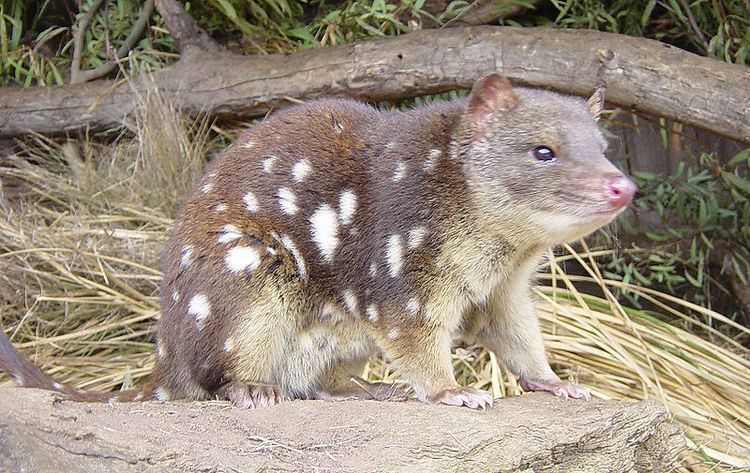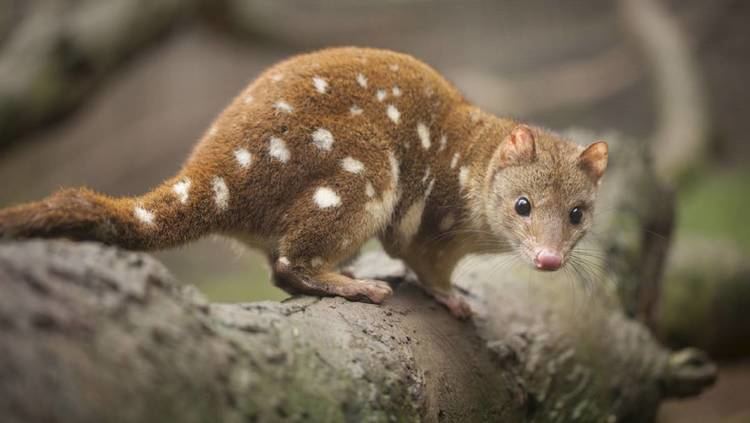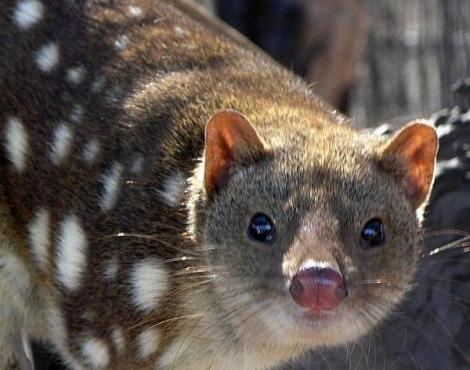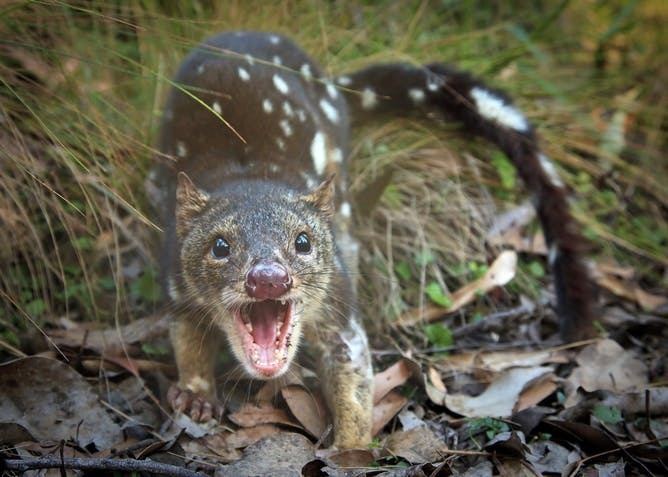Infraclass Marsupialia Scientific name Dasyurus | Phylum Chordata Rank Genus | |
 | ||
Lower classifications Tiger quoll, Eastern quoll, Northern quoll, Western quoll, New Guinean quoll | ||
Domestication could save quolls
The quoll (/ˈkwɒl/; genus Dasyurus) is a carnivorous marsupial native to mainland Australia, New Guinea, and Tasmania. It is primarily nocturnal and spends most of the day in its den. Of the six species of quoll, four are found in Australia and two in New Guinea. Another two species are known from fossil remains in Pliocene and Pleistocene deposits in Queensland. Genetic evidence indicates that the quoll evolved around 15 million years ago in the Miocene, and that the ancestors of the six species had all diverged by around four million years ago. The quoll species vary in weight and size, from 300 g (11 oz) to 7 kg (15 lb). They have brown or black fur and pink noses. They are largely solitary, but come together for a few social interactions such as mating which occurs during the winter season. A female gives birth to up to 18 puppies, of which only six survive.
Contents
- Domestication could save quolls
- Taxonomy
- Description
- Distribution and habitat
- Behaviour
- Diet
- Reproduction
- Threats
- Conservation efforts
- References

The quoll eats smaller mammals, small birds, lizards, and insects. Its natural lifespan is between two and five years. All species have drastically declined in numbers since Australasia was colonised by Europeans, with one species, the eastern quoll, becoming extinct on the Australian mainland, now being found only in Tasmania. Major threats to their survival include the cane toad, predators, urban development, and poison baiting. Conservation efforts include breeding programs in captivity, one of which is taking place in Tasmania with support from Rewilding Australia and Conjour.

Taxonomy
The name Dasyurus (from Greek δασύουρος, dasyouros) means "hairy-tail", and was coined by Étienne Geoffroy Saint-Hilaire in 1796.

In 1770, Captain Cook collected quolls on his exploration of the east coast of Australia, adopting the Aboriginal name for the animals. Although the origin of Cook's specimens are unclear, the word and its variants je-quoll, jaquol or taquol are derived from the language of the Guugu Yimithirr people of far north Queensland. No evidence indicates the local indigenous people used the word in the Sydney area. They were likened in appearance to a polecat or marten in the earliest reports, the tiger quoll being called "spotted marten" and eastern quoll "spotted opossum", but by 1804, the names "native cat" and "tiger cat" had been adopted by early settlers. In the 1960s, noted naturalist David Fleay pushed for the revival of the term "quoll", as he felt the then current vernacular names were misleading. They are very well known animals in Australia.
Four species have been recovered from Pleistocene cave deposits from Mount Etna Caves National Park near Rockhampton in central Queensland. Remains of the tiger quoll and the northern quoll, and a species either identical or very similar to the eastern quoll, as well as a prehistoric species as yet undescribed, all lived in what was a rainforest climate. The northern quoll is still found in the region. The fossil species D. dunmalli, described by Bartholomai in 1971, is the oldest species recovered to date. Its remains were found in Pliocene deposits near Chinchilla in southeastern Queensland. Known only from a lower jaw and some teeth, it was a relative of the tiger quoll.
The first species described, the eastern quoll, was originally placed in the American opossum genus Didelphis by an anonymous author, and named Didelphis maculata. This name is no longer considered valid, and the second part of the name is now given to a different species, the tiger quoll, Dasyurus maculatus, while the eastern quoll was renamed Dasyurus viverrinus by George Shaw in 1800.
The tribe Dasyurini, to which quolls belong, also includes the Tasmanian devil, the antechinus, the kowari, and the mulgara. Genetic analysis of cytochrome b DNA and 12S rRNA of the mitochondria indicates the quolls evolved and diversified in the late Miocene between 15 and 5 million years ago, a time of great diversification in marsupials. The ancestors of all current species had diverged by the early Pliocene, around 4 million years ago.
The genus Dasyurus consists of six species of quoll:
The following is a phylogenetic tree based on mitochondrial genome sequences:
Description
Adults are between 25 and 75 cm (9.8 and 29.5 in) long, with hairy tails about 20 to 35 cm (7.9 to 13.8 in) long. Females have six nipples and develop a pouch during the breeding season, which opens toward the tail (with the exception of the tiger quoll, which has a true pouch) when they are rearing young. Their coats are brown or black, with some colour variants in between. They have bright pink noses and long snouts. Their natural lifespans are between two and five years; the larger species tend to live longer than the smaller. Quolls are solitary, nocturnal animals. The average weight differs greatly depending on the species; male western and eastern quolls weigh about 1.3 kg (2.9 lb) and females 0.9 kg (2.0 lb). The tiger quoll is the largest, with the male weighing about 7 kg (15 lb) and the female 4 kg (8.8 lb). The northern quoll is the smallest, and the male weighs on average 400 to 900 g (14 to 32 oz), and the female 300 to 500 g (11 to 18 oz).
Distribution and habitat
The quoll is indigenous to mainland Australia, New Guinea, and Tasmania. The six species were once widely distributed across the three land masses, but are now restricted to only a few areas. Although primarily ground-dwelling, the genus has developed secondary arboreal characteristics. Each species of quoll lives in distinct geographical areas. The tiger quoll and eastern quoll are exclusively mesic zone species, that is they inhabit moister habitats. The western quoll also inhabits mesic habitat, but has adapted to arid regions across inland Australia, while the northern quoll inhabits tropical habitat of high rainfall.
Behaviour
The quoll is a carnivorous marsupial. It is primarily nocturnal, sleeping in hollowed-out logs or rocky dens and coming out to hunt during the night, though on rare occasions it can be seen looking for prey during the day. It is mostly ground-dwelling, but it is not uncommon to see a quoll climbing a tree. The quoll marks its territory several kilometres away from its den. A male's territory often overlaps many females' territories, and male and female quolls only meet for mating. Quolls have communal toilet areas, usually on an outcropping used for marking territory and social functions. These communal latrines may have up to 100 droppings in them.
The quoll is a mostly solitary creature, limiting contact with others to mating or other social activities such as using the latrines.
Diet
The quoll is mostly carnivorous; the smaller quolls primarily eat insects, birds, frogs, lizards and fruit; the larger species eat birds, reptiles, and mammals, including echidnas and possums. The tiger quoll's diet is dominated by mammals such as brushtail possums, rabbits and hares. The exact mix is variable depending on the availability of prey after bushfires, and can include carrion or bandicoots when food is scarce. The other species of quoll have also been known to eat carrion. The quoll's paws and vibrissae allow it to reach into small burrows to find prey. The quoll hunts by stalking. Depending on the size of its prey, the quoll may leap or pounce on it. It pins small prey down with its front paws while devouring it, and jumps onto larger prey, sinking in its claws and closing its jaws around the neck. The quoll can obtain all the water it needs from its food, making it quite adaptable during droughts or other periods of water shortage.
Reproduction
Mating occurs during the winter months. Once a female quoll has been impregnated, the folds on her abdomen convert into a pouch that opens at the back. The gestation period is 21 days. A baby quoll, or pup, is the size of a grain of rice. Up to 18 quolls are born in each litter, but only six survive the first two weeks. The survivors stay in their mother's pouch for eight weeks, suckling on one of the mother's six teats for milk. During the ninth week, the pups venture out of the pouch and onto the mother's back, where they remain for six weeks. The quoll reaches maturity when it is one year old, and has a natural lifespan of between two and five years. A 2008 study of the pouches of tiger quolls reported the pouches' appearance' were reliable indicators of the quolls' reproductive status: during the follicular phase, pouches were found to be red and have many secretions. After ovulation, pouches became deep and wet. Researchers can use this information to determine where a female quoll is in her ovarian cycle, which is anticipated to be helpful in breeding management.
Threats
Cane toads were introduced into Queensland in 1935; their numbers have since grown exponentially. These poisonous toads pose a significant threat to the northern quoll, which may die after consuming one. The Department of Sustainability, Environment, Water, Population and Communities has stated that cane toads are highly invasive and are major threats to the quoll's survival.
Predators such as foxes and cats prey on quolls and compete with them for food. For example, both quolls and foxes catch and consume rabbits. Since the introduction of foxes, the quoll population has dropped dramatically. Foxes have been eradicated from many of the islands off the coast of Australia in an effort to protect the quoll.
The quoll is suffering badly from urbanisation, housing development, mining development, and expansion of agricultural lands. Habitats are also being destroyed by large herbivores trampling the grass and overgrowth, making camouflage difficult. Forest fires and weeds also contribute to habitat destruction.
The natural poison fluoroacetate (Compound 1080) is commonly used in Australia to control introduced pests such as European rabbits, foxes, feral predators, and wild dogs such as dingoes. The poison is extremely toxic to introduced pests, but less so to native animals as it is found naturally in many Australian plants. However, juvenile quolls may be susceptible to the poison. Research is underway to determine whether the number of quolls protected from predators may be less than those killed by the poison.
Conservation efforts
Since 1770, all Australian quoll species have declined in number owing to habitat loss caused by urbanization. The northern quoll is threatened by toxic cane toads, but a University of Sydney project revealed in 2010 is teaching them to avoid eating the invasive amphibians. In 2008, the Northern Territory Wildlife Park in Australia recorded their first litter of quoll pups in the park. The quolls bred well in captivity, with over 15 litters in the 2008 breeding season alone.
In late October 2011, a litter of five tiger quoll pups was born at Wild Life Sydney in Darling Harbour, Australia. The pups were born to inexperienced parents, both just one year old. The reason for the young parents was because older male quolls can become violent and kill the female if they do not want to mate. By breeding one-year-old quolls, there was no threat of violence. Four of the quoll pups will be sent to other zoos or wildlife parks across Australia, but one, which the researchers named Nelson, will stay at the centre to become an "ambassador for all quolls".
Fox control programs have benefited the western quoll. The Department of Environment and Conservation (Western Australia) monitors western quoll populations in the Jarrah Forest as part of its faunal management programs, as well as ongoing research into fox control, timber harvesting, and prescribed burning. The Perth Zoo has been monitoring a successful captive-breeding program since 1989. It has successfully bred more than 60 western quolls, most of which it transferred to Julimar Conservation Park, with proposals to translocate to Wheatbelt reserves and Shark Bay.
The bronze quoll is kept in Wasur National Park and Tonda Wildlife Management Area. More research on distribution and threats is needed for further conservation.
Creating a native pet industry in Australia related to quolls could aid in their conservation. However, concerns exist about this methodology in regards to animal husbandry, conservation benefits, and other issues. Some scientists believe that keeping quolls as pets could aid in their long-term conservation, but further research is needed on this topic to conclude whether this is true or false.
